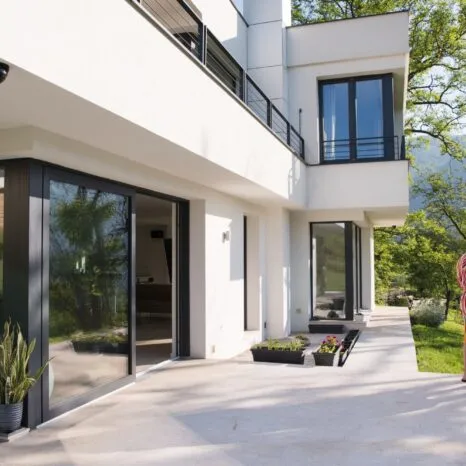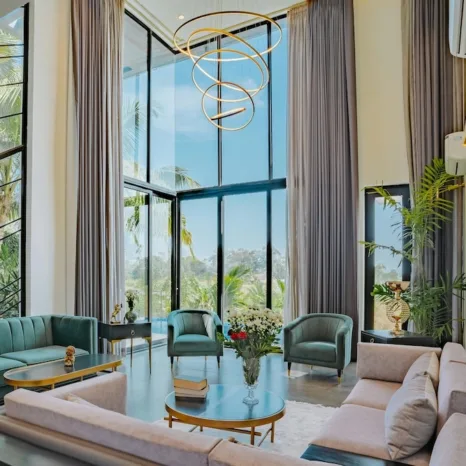Dream effect or designer suggestion? Spacious glazed walls – panoramic windows – are increasingly common in modern interior designs.
Although the appearance of the windows (or rather what is behind them) can undoubtedly impress, this type of solution is not chosen by all customers. Why? There are several reasons. You can read about the many advantages and challenges of installing panoramic windows below.
What are panoramic windows and how do they differ from classic solutions?
Panoramic windows are large glazings that (often, but not always) extend from floor to ceiling. They occupy a significant part of the building wall – exterior and interior.
Panoramic window joinery models differ from these traditional windows in size and therefore in the amount of daylight let in – the minimal frame maximises the glazed space. They are usually fixed or have small tilting sections. This unfortunately limits their openability, but provides exceptional structural stability and excellent insulation performance.
Panoramic windows can also be a design challenge that requires a very careful approach to their specification and alignment with the rest of the building.
Why is it irresistible? Advantages that speak for choosing panoramic windows
Why do many of us want a beautiful panorama? There are many reasons, but we detail the ones that clients mention most often.
Unparalleled access to natural light
One of the biggest advantages of panoramic windows is the amount of natural light that enters the room. With large glazing, interiors become brighter, reducing the need for artificial lighting during the day.
Larger glazings also have a positive effect on mood. It may not be an obvious connection, but it is worth mentioning – daylight helps regulate the diurnal rhythm and influences concentration and productivity. However, it is worth bearing in mind that on sunny days, intense sunlight can lead to overheating. Panoramic solutions may require the ventilation and air-conditioning system to be designed accordingly – but these issues are, in any case, taken into account in the designs.
Direct connection to nature
Panoramic windows are often used in buildings that focus on integration with their surroundings. They allow you to get a full view of the greenery, mountains, lakes or the city skyline. This type of solution allows you to enjoy nature without having to go outside – ideal for both detached houses and flats.
Glazed walls also offer a sense of space and add lightness to interiors (which is difficult to achieve with traditional windows).
Modern design – an unmistakable effect
The aesthetics of the panoramic windows emphasise the modern design. The wide glazing gives the interior a modern style and an impression of spaciousness. This effect is particularly attractive in small flats.
Modern glazing systems can be matched in colour and style to the other elements of the building. This allows us to achieve not only a beautiful panorama, but also a coherent composition of the entire interior.
Improved air quality and thermal comfort
Modern panoramic windows are fitted with high-performance insulating glass and frames with a low heat transfer coefficient.
As a result, they can improve thermal comfort, minimising heat loss in winter and reducing heat build-up in summer (even with such large glazing). In addition, some models can include UV-protective layers – a great solution to prevent fading of furniture and floors.
Things to know before you buy – challenges to overcome
Is ‘large glazing’ a ‘big problem’? Absolutely not! However, as with most non-standard solutions, we have to reckon with issues that may cause us some challenges. However, these are not ‘problems’, but some dependencies that can easily be resolved.
Cost of installation and specifics of construction
High-quality panoramic windows are an investment that requires more money than standard solutions. It is not just about buying the windows themselves – the installation of large glazing requires specialised tools, proper preparation of the wall structure and may require structural changes.
It is therefore worth planning this investment, taking into account the costs not only of the window itself, but also of all the necessary installation work.
The need for adequate ventilation and protection from the sun
Large glazings, especially in south-eastern buildings, can lead to excessive interior heating. This problem can be partly solved by using glazing with improved thermal insulation properties, as well as additional shielding (e.g. external blinds or special awnings).
A well-designed ventilation system, possibly a combination of panoramic windows and air conditioning, will be essential to maintain thermal comfort.
Maintenance requirements and care of large glazings
Due to the large glazed area, panoramic windows require regular maintenance (washing and polishing) to keep them looking aesthetically pleasing and functional. Keeping the entire glass surface clean can be a challenge, especially in multi-storey buildings.
It is often necessary to use special cleaning systems or employ window cleaning companies.


















